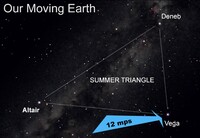Week of November 9-15, 2025
If you're seated while reading these words — as I am writing them — you're most likely convinced that you and the room around you are stationary. What if I were to tell you, however, that this just is not true?
It might be hard to believe, but when we view things from a more cosmic perspective, we begin to understand just what an incredible journey we and our planet are on. Some of these motions might be familiar to you; others may surprise you. But all carry us in at least seven different directions at more than a million miles per hour!
Let's start with the simplest. Everyone has noticed how the sun rises in the east, drifts slowly westward across the daytime sky, and sets in the west each evening. Though ancient skywatchers didn't realize it, we're watching a remarkable illusion caused by the rotation of our Earth in the opposite direction. Every second of every minute of every day, our world spins like this while carrying us in middle-northern latitudes around at nearly 900 mph.
And what about how the nighttime sky changes from season to season? Why do we see Scorpius in the summer and Orion in the winter? Well, that's because our planet is orbiting the sun and allowing us on the nighttime side to gaze outward in different directions as we go. This journey carries us at 66,000 mph — fast enough that an average human lifetime will transport us some 45 billion miles through space.
Don't be fooled, though. Our sun isn't static; it's moving too. It's towing our Earth and entire solar system behind at 12 miles per second in the direction of the bright star Vega, appearing high in the western sky this week. No need to worry about a collision; even at this extraordinary speed, we'd need 5,300 human lifetimes to reach that star!
But wait, there's more!
Even our Milky Way galaxy is spinning and carrying us along at about 140 miles per second. Only two dozen times over the 5-billion-year history of our planet have we passed this way; the last time, the first small dinosaurs were beginning to appear. The next? Who knows!
In addition, our Milky Way is careening at 50 miles per second toward the Great Andromeda galaxy, one of some 50-plus such structures that form a galactic collection known to astronomers as the "Local Group," which itself is falling toward the Virgo supercluster at another 150 miles per second.
And if that's not enough, beyond lie even more galaxy superclusters as far as the largest telescopes can see. All appear to be receding from each other as if hurled from a huge cosmic explosion 13.8 billion years ago. Between these superclusters glows the faint, ghostly echo of this primordial fireball through which we speed at more than a million miles per hour.
Is there more? What about the universe itself? Is it turning about an even larger universe? Is it speeding along in some unknown direction at an even more incredible speed? No one knows for sure, but it sure is fun to ponder the dizzying possibilities!
(SET CAPTION) Earth orbits the sun at a speed of 66,000 mph, and as the sun itself moves, it tows Earth (and the rest of the solar system) along with it at a speed of 12 miles per second. (END CAPTION)Visit Dennis Mammana at dennismammana.com. To read features by other Creators Syndicate writers and cartoonists, visit the Creators Syndicate website at www.creators.com.







View Comments